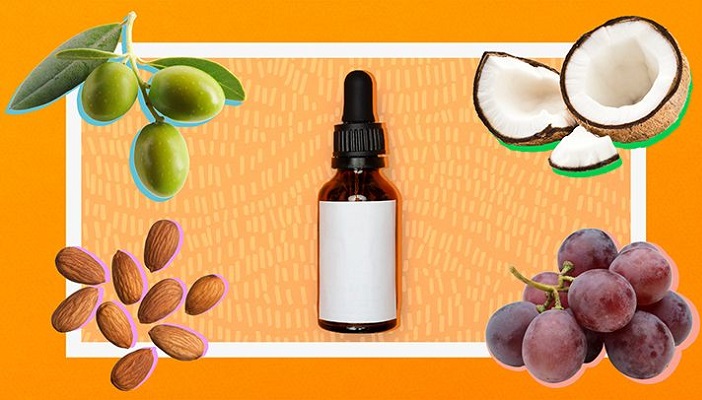We decided to investigate and address here the question of “mineral oil” as a widely used raw material and which has caused so much controversy. There are several questions about its use in cosmetics: Is mineral oil comedogenic? And if it is, is it still widely used in cosmetics? Is there a possibility that mineral oil causes skin cancer or is a source of toxins for the skin? After all, aren’t vegetable oils “natural” or organic, and therefore better than mineral oil? These are some of the issues surrounding this raw material, which has been used for more than 100 years in cosmetics, so let’s see what is real.
Index
Mineral oil and… organic?
The fact that mineral oil is derived from petroleum makes it also known as paraffin oil, liquid petroleum jelly, and white mineral oil . One of the statements that is against its use is that it would not be organic like vegetable oils, this information is misleading because mineral oil is made up of hydrocarbons. Hydrocarbons are organic molecules (that is, they contain carbon), and we cannot forget that oil has its origin in plants and animals of prehistoric times that were pressed into layers of rock. Therefore, mineral oil, according to this line of thought, is also organic, but with a different composition from vegetable oils.
Looking back:
Do not confuse: (a) Concept of chemistry in “organic compound” (b) the marketing concept of “organic product”, which is a term that is used throughout the world by the food and cosmetics market to indicate products that they claim are chemical-free or totally natural. WE THINK: If we understand that everything around us is chemistry, just look at the composition of water, which is H2O. So can we say that something chemical-free is totally natural? |
For the purity of mineral oil to be ensured for use in cosmetics, it has to be highly refined . It can be obtained in large quantities at low cost, in addition to being colorless, non-toxic, having a long shelf life and not subject to oxidation, as occurs with vegetable oils, the truth is that there is also a difference in action between these two raw materials .
Mineral Oil Vs Vegetable Oils

Mineral oil does not penetrate the layers of the skin, it acts only on the surface, exerting an occlusion function , that is, in a positive way, we can say that it has an excellent ability to reduce water loss through the skin , therefore, it contributes to the maintenance of hydration . Mineral oil also has a high emollient power, leaving the skin smoother, making it easier to incorporate into the formula and without interfering with the desired organoleptic characteristics.
Since vegetable oils with a more complex composition offer a less occlusive effect, the composition and sub-rich extracts, which are the donors of other active ingredients (such as vitamins, proteins, antioxidant, anti-inflammatory, curative enzymes) will vary. depending on the species of plant from which it was extracted. And the formula is difficult to manipulate so as not to leave a sticky touch, stabilize and, above all, hide the characteristic smell of the oil, or prevent it from going rancid.
It is important to know that cosmetics with a high concentration of oils , be they mineral or vegetable, are not suitable for those who have a facility to perspire, for those who practice sports, those who work in hot areas or have very oily skin .
AND NOW? Does the occlusive effect mean to be comedogenic? SO, is mineral oil comedogenic?
So here we go: in 1970 came the concept of cosmetic acne. The researchers believed that the various raw materials present in cosmetics, including mineral oil, were causing an acne breakout when these products were used. At the time some animal tests were carried out with mineral oil, and in conclusion, it was added to the list of comedogenic raw materials. It was not until 2005 that science conducted new studies, and now it is clear that NO, NO, mineral oil is not comedogenic. Unfortunately, this reputation still haunts you and it’s going to take a long time to be invested after the barrage of decades of marketing campaigns.
Does Mineral Oil Cause Cancer?

The suspicion that mineral oil can cause cancer by having toxic compounds in its composition is also unfounded , it is true that if it is not refined and purified, it contains toxic impurities. But please! THIS TYPE OF OIL IS intended for other purposes, not admitted for use in the COSMETIC industry! It is important not to confuse! What brings a light to the truth in the great controversy is the presence of 1,4-dioxane, which is a carcinogen, in mineral oil.
When asked about the possibility we were told:
| Final opinion: Dear xxxx Evaluating the information available here, we see that there is a wrong marketing. This component in mineral oil, 1,4-dioxane, which is attributed carcinogenic effects, is prohibited for use in cosmetics , in accordance with the provisions of RDC 48/06. The IARC – International Agency for Cancer – does not present data that tangibly link the use of mineral oil with cancer. With the mission of protecting public health, it would never allow a substance considered carcinogenic to be used in products subject to sanitary regulations, such as cosmetics, toiletries and perfumes. Sincerely, general manager of cosmetics. |
And even so…
| In response to your request, it is reported that mineral oil (other names: liquidum paraffin ) is allowed for use in cosmetics and is therefore not included in the list of prohibited substances in cosmetics. There is use of references of this substance in cosmetics. There is not enough scientific data to link the incidence of cancer to the use of mineral oil in cosmetics, which to date is considered safe for use. |
We can only say that mineral oil is considered a safe substance , and if it posed a risk to the health of the population, its use would be prohibited. It is clear that crude oil is not allowed for use in the cosmetic industry. At this point comes the responsibility of the industries to use mineral oil suitable for cosmetic use and of us when selecting products with guaranteed quality.
Purified mineral oil is not prohibited for use in the cosmetic industry, which guarantees the use of this substance safely and suppliers send purity tests and documents that prove the quality.
In Europe, the cosmetic industries adhere to good manufacturing practices that ensure that they only use raw materials correctly and of reliable origin.
Of course, there are also downsides. The fact is, mineral oil is not “cosmetically fancy.” The lower the consistency of the oil added to the product, the more pleasant it is to touch, but the best mineral oils have less ability to maintain skin hydration . That is why the industry works to create formulas, modern and complex formulations, that allow a better extension and hydration capacity.
Conclusion on mineral oil

Regarding the use of mineral oil, the ideal would be for companies to inform customers about the technology used. They already use this resource to blind the eyes of the user, and if this is an ethical question, it must be rethought! After all the studies showed what appeared to be a great need to protect the consumer, over the years and various scientific research activities it was shown that it was only a commercial appeal.
Today science shows that it is okay to USE cosmetics that contain mineral oil . So if you have any doubt about the concepts exposed in the media, this is very good, the doubt is healthy, since the doubt is accompanied by the search for information. So we can make the best decisions!
Kathie Sand always saw the world of beauty as the terrain on which to build her professional career, a goal that was clear to her when she was only 15 years old. Her great concern to expand knowledge led her to settle in Paris where she studied hand in hand with the best beauty professionals and with the most advanced techniques for skin care.



